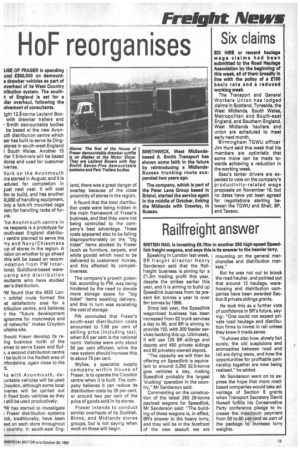HoF reorganises
Page 7

If you've noticed an error in this article please click here to report it so we can fix it.
USE OF FRASER Is spending und 000,000 on demount. drawbar vehicles as part of overhaul of its West Country trlbution system. The southit of England Is set for a 'liar overhaul, following the olvement of consultants.
ight 12.d-tonne Leyland Box with drawbar trailers and Smith demountable bodies
be based at the new Avonuth distribution centre which ser has built to serve its Dingstores in south-west England I South Wales. Another 15 rier 7.5-tonners will be based ;tares and used for customer ivories.
Vork on the Avonmouth Ire started in August, and it is eduled for completion in gust next year. It will cost Bm to build, and has another 10,000 of handling equipment, inly a fork-lift mounted cage tern for handling racks of fur
ire.
'he Avonmouth centre in ne respects is a prototype for touth-east England distribu
centre planned to serve the Tly and Navy/Chiesmans ,up of stores in the region. A :ision on whether to go ahead this will be based on recomIndation from PW InterIona!, Guildford-based wareusing and distribution isultants who have studied ser's distribution.
NV found that the M25 Lon orbital route formed the 1st satisfactory area for a tribution centre, and believes it the "future development )gramme for motorways and id networks" makes Croydon uitable site.
ihould Fraser develop its reing business north of the 3mes to serve Essex and Suf(, a second distribution centre I be built in the Radlett area of rtfordshire, again close to the 15.
ks with Avonmouth, deiuntable vehicles will be used 3roydon, although some local iveries will be carried out h fixed body vehicles as they I still be used productively.
'W has started to investigate s Fraser distribution systems lich, traditionally, have been sed on each store throughout s country. In south-east Eng
land, there was a great danger of overlap because of the close proximity of stores in the region.
It found that the total distribution costs were being hidden in the main framework of Fraser's business, and that they were not being controlled to the company's best advantage. These costs appeared also to be falling disproportionately on the "big ticket" items stocked by Fraser (such as furniture, carpets, and white goods) which need to be delivered to customers' homes, and this affected its competitiveness.
The company's growth potential, according to PW, was being hindered by the need to devote more storage space for "big ticket" items awaiting delivery, and this in turn was escalating the cost of storage.
PW concluded that Fraser's south-east distribution costs amounted to 7.69 per cent of selling price (including tax), when 6.5 per cent is the national norm. Vehicles were only about 50 per cent efficient, while the new system should increase this to about 75 per cent.
Wylies, a specialist supply company within House of Fraser, is to operate the Croydon centre when it is built. The company believes it can reduce its distribution costs by 25 per cent, or around two per cent of the price of goods sold in its stores.
Fraser intends to conduct similar overhauls of its Scottish, Binns, and Midlands stores groups, but is not saying when work on these will begin.






































































